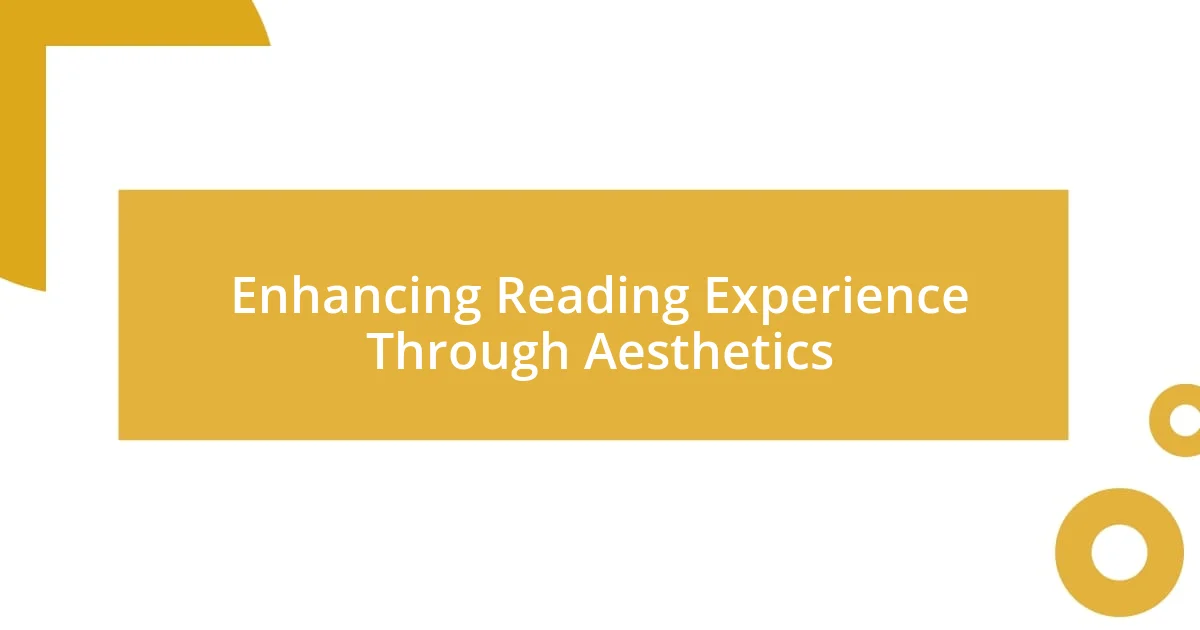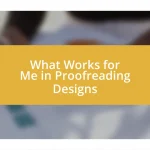Key takeaways:
- Book aesthetics encompass visual elements like cover design, typography, and texture, which evoke emotional connections and enhance the reading experience.
- Color schemes significantly influence reader expectations and emotions, affecting their engagement with the story even before reading begins.
- Personalizing a book collection through thematic arrangements and decorative touches enriches the reading journey and reflects individual experiences and tastes.

Understanding Book Aesthetics Values
When I think about book aesthetics, I realize it goes beyond just the cover design or the paper quality; it’s about the emotional response they elicit in me. Have you ever picked up a book and felt an inexplicable connection to its visual elements? I remember holding a vintage edition of a classic novel, its worn cover and frayed edges whispered stories of previous readers, making me feel part of a larger literary journey.
Color schemes and typography also play a significant role in how I perceive a book. I was drawn to a sci-fi novel solely because of its sleek, silver cover accented with bold, futuristic font. That moment reminded me that the visual aspects of a book can enhance my anticipation and investment in the story within, as they set the tone even before the first page is turned.
Additionally, the tactile experience of a book often amplifies its aesthetic value for me. I still cherish the smooth texture of a hardcover against my palm, which evokes a sense of warmth and permanence. Doesn’t it feel wonderful to dive into a beautifully bound book, letting its aesthetics enhance not just the reading experience but also the deeper connection with the narrative?

Elements of Attractive Book Design
When I think about the elements that make a book visually appealing, the cover design immediately springs to mind. A captivating illustration can draw me in like a moth to a flame. I remember one summer afternoon when I stumbled upon an illustrated fantasy novel; its whimsical artwork transported me to another world even before I read the blurb. It’s fascinating how a striking cover can spark curiosity and make one feel connected to the story waiting inside.
Another crucial aspect is the choice of fonts and text layout. I often find myself pausing over the elegant script on a classic poetry collection I own. The precise spacing and size of the text not only made it comfortable to read but also elevated the overall aesthetic appeal. Each poem felt amplified by the thoughtful design, inviting me to linger on each page longer than I intended. It’s incredible how these subtle details can enhance my emotional engagement with the content.
Lastly, the texture and weight of the book are often overlooked but deeply felt. There’s something satisfying about flipping through the pages of a well-made paperback or hardcover. I remember cradling a beautifully embossed edition of my favorite novel—the raised lettering pressing gently into my fingertips added a new level of appreciation. The way a book feels in my hands often mirrors the quality of the narrative, creating a tactile connection that enriches my overall experience.
| Element | Description |
|---|---|
| Cover Design | Visually striking covers attract attention and evoke curiosity about the content |
| Typography | Fonts and text layout impact readability and enhance emotional connection |
| Texture and Weight | Physical feel of the book adds to the reading experience and perceived quality |

Importance of Typography in Books
The significance of typography in books cannot be understated. I’ve often marveled at how the right font can completely shape my reading experience. For instance, I once read a beautifully formatted historical fiction book that employed a serif typeface. The classic look not only suited the setting but also made each paragraph feel like a window into the past. Every time I turned a page, it felt as though I was stepping into a different time, seamlessly guided by the typography.
- Typography influences readability, helping to prevent reader fatigue.
- Different fonts convey diverse moods, impacting the emotional tone of the story.
- Well-chosen typographic elements, like line spacing and margins, enhance the overall flow and pacing of the text.
Typography acts like a silent partner in storytelling, subtly shaping the way a narrative unfolds. I remember getting lost in a graphic novel where the combination of bold type and creative lettering brought dialogue to life. The playful variations enhanced the character’s emotions, eliciting laughs and gasps at the right moments. That experience reaffirmed my belief that typography isn’t just functional—it’s an integral part of the immersive journey that books provide.

Color Schemes and Their Impact
Color schemes in book design have an incredible ability to influence the emotions and expectations of readers. I often find myself drawn to covers that utilize vibrant hues—think rich reds or deep blues—because they evoke strong feelings. For example, I remember picking up a thriller novel with a striking black and yellow cover; the bold contrast immediately signaled tension and excitement, making me eager to dive into the story.
When I think about softer color palettes, like pastels, I’m reminded of the charming children’s books that adorned my bookshelf as a child. These gentle colors created a sense of warmth and whimsy, inviting me to explore imaginary worlds. It’s interesting how these color choices can shape our perceptions right from the moment we lay eyes on a book. Have you ever considered how the colors used in a book’s design reflect the story within?
In my experience, the color scheme often sets the mood before I even read the first word. I recall a beautifully designed romance novel that showcased soft pinks and creams on its cover. Those colors instantly made me feel a sense of tenderness and hope, which beautifully complemented the storyline. The psychological impact of such colors is profound, turning a mere book into an emotional experience. Are we not more inclined to pick up a book that visually reflects the emotions we seek, whether it’s comfort, thrill, or nostalgia?

Role of Illustrations in Aesthetics
Illustrations play a pivotal role in enhancing the overall aesthetics of a book, serving as visual extensions of the story’s themes and emotions. I can recall poring over an illustrated edition of a classic novel, where the delicate sketches beautifully echoed the text, making every scene come alive. The images provided layers of meaning that words alone couldn’t capture, allowing me to connect more deeply to the story’s heart.
Beyond merely complementing text, illustrations can evoke nostalgia and whimsy that resonate with readers on multiple levels. I remember diving into a children’s book adorned with charming, colorful images; each page turned felt like opening a gift, filled with delightful surprises. Those illustrations didn’t just tell a story—they sparked my imagination, encouraging me to visualize my own adventures and live in the world of the narrative.
Isn’t it fascinating how a well-placed illustration can evoke an emotional response? In my own reading journey, I’ve found that illustrations can create a strong sense of atmosphere. For instance, an illustrated fantasy novel I cherished transported me to realms of wonder, where vibrant dragons and enchanted forests danced into view. Those images transformed the reading experience into a visual feast, reminding me that literature can be as much about what we see as what we read.

Personalizing Your Book Collection
Personalizing your book collection can be a rewarding journey, and I find joy in curating a space that reflects my tastes and memories. When I arrange my books, I often place my favorites front and center, those that not only captivate my imagination but also evoke cherished moments. For instance, I still vividly remember the summer I discovered a hidden gem—an old, leather-bound novel at a flea market. Its worn pages and distinct smell whisked me away, instantly making it a centerpiece of my collection, a tangible reminder of that adventurous day.
Beyond simply organizing by genre or author, I love to explore thematic arrangements that resonate with my life experiences. Creating a shelf dedicated to travel narratives speaks to my wanderlust; every time I catch a glimpse, I’m reminded of the inspiring stories that fueled my own adventures. I sometimes wonder—doesn’t a collection become more alive when it mirrors our journeys, both the ones we’ve taken and those we dream of?
Incorporating personal touches, like decorative bookmarks or framed photos of places that inspire me, can enhance the visual beauty of a book display. I remember adding a small potted plant next to a collection of nature essays, which not only brightened the shelves but also transcended the experience of reading those texts. It invites me to pause, breathe, and reflect on the connection between the words and the world around me. How do you personalize your collection to infuse it with your own unique story?

Enhancing Reading Experience Through Aesthetics
Aesthetics enhance the reading experience by creating an immersive environment that engages all the senses. I remember the first time I held a beautifully bound edition of my favorite poetry. The embossed cover felt luxurious in my hands, and the soft, creamy pages almost begged to be turned. With every poem, the gentle fragrance of the ink and paper enveloped me, wrapping me in an experience that was just as much about the touch and smell as it was about the words.
Typography also plays a critical role in shaping how we perceive text on the page. I’ve often found that the right font can set the tone even before I start reading. Take, for instance, a whimsical children’s book I recently picked up; the playful lettering felt like an invitation to dive into a magical world. Every letter danced across the page, making the reading feel joyful and light, almost as if the type itself was telling a story alongside the content.
What strikes me the most, though, is how the visual elements of a book can influence my mood. I recall a rainy afternoon when I was nestled on my couch, absorbed in a dark, atmospheric novel adorned with shadowy illustrations. The visuals underscored the tension on every page, making my heart race as I turned the corners. It’s an incredible realization – how a book doesn’t just tell a story, but also creates an entire world wrapped in visual allure. How has a book’s aesthetics transformed your reading moments?















